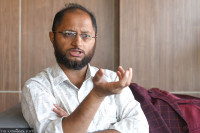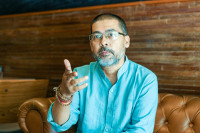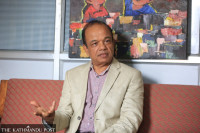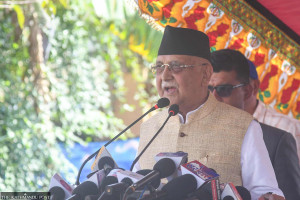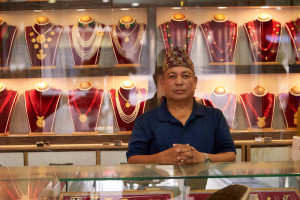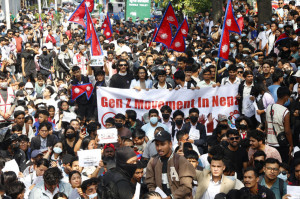Interviews
There is disconnect between Nepal’s LGBTQIA+ rights image and reality
Our ultimate goal is to amend the Civil Code so that marriage is defined as a union between two individuals, rather than being restricted to one between male and female.
Aarati Ray
Nepal has often earned global recognition for its progressive policies and inclusive stance on LGBTQIA+ rights. But do the global accolades Nepal has earned in terms of its progressiveness reflect the actual experiences of queer people here? The Post’s Aarati Ray sat down with Manisha Dhakal, executive director of the Blue Diamond Society and a leading advocate for LGBTQIA+ rights in South Asia for over 23 years.
Nepal is often hailed for its progressive stance on queer rights, both in South Asia and globally. With over two decades of queer rights advocacy, how accurate do you find this portrayal?
Many activists and commentators do describe Nepal as being progressive on queer rights. While this is partly true, especially when we consider the legal frameworks, the reality at the grassroots is quite different.
On the one hand, Nepal’s constitution recognises LGBTQIA+ identities. Articles 12 and 18 mandate that “gender identity” be acknowledged on citizenship certificates, while Article 42 promises affirmative action and participation in government for sexual and gender minorities.
Court decisions in Nepal, too, have been favourable for LGBTQIA+ rights, and unlike many former British colonies with Section 377-type laws that criminalise queer communities, Nepal has no such legal barriers.
So, indeed, there are opportunities for activism, and progress has been made, particularly in terms of legal recognition. But, again, the rights enshrined in the constitution and affirmed by the courts have not been realised at the grassroots level.
We are stuck with a limited focus, primarily on citizenship. The state claims that we’ve been given the right to identity and legal recognition, but even this is not fully realised.
For example, the process of obtaining citizenship based on self-identification remains difficult, with government officials still unclear on how to implement these provisions. The broader narrative of Nepal being progressive is built on a superficial understanding of the situation.
In August, Nepal’s Supreme Court ruled that Rukshana Kapali, a transgender woman, should be legally recognised as a woman on all documents without medical verification. How does this decision impact the future of LGBTQIA+ rights in Nepal?
Rukshana’s case is a prominent victory, highlighting the judiciary’s support for LGBTQIA+ rights, especially compared to those of the executive and legislative branches. This ruling lays a strong foundation for similar future cases and will undoubtedly help in future activism.
However, it’s important to note that the decision applies only to Kapali, meaning others will still need to go through the courts to have their gender identity legally recognised. How long must transgender individuals continue to endure lengthy court processes just to obtain citizenship?
Even outside the courts, the bureaucratic hurdles—from medical reassignment surgeries to invasive checkups and long delays from the CDO (District Administration Office) to the Ministry of Home Affairs—can take years, with no guarantee of getting preferred names on legal documents. In many cases, even after completing the process, the names are inaccurately changed, such as altering Ram to Rama instead of the preferred name, like Manisha.
We [Blue Diamond Society] get 15-20 complaints each year, primarily from transgender women, regarding difficulties in obtaining citizenship.
The Supreme Court’s recent decision on same-sex marriage in Nepal has attracted global attention and gotten a positive response. Are there any limits to the court’s decision?
After a long and arduous process, we secured temporary registration for same-sex marriages. On June 28, 2023, the Supreme Court, in the Pinky Gurung vs. Government of Nepal case, issued an interim order instructing the government to temporarily register same-sex marriages, including for those with “other” gender markers.
That said, the Civil Code adopted in 2017 still defines marriage as a union between a ‘man’ and a ‘woman’.
We, as a community, are pleased with the government’s temporary registration process. Yet it falls short of offering full marriage rights, including those related to property, adoption, and tax exemptions. While the court’s decision sets a supportive precedent, lack of clarity about the rights associated with the temporary certificate leaves many in limbo. So far, only around five couples have registered, and many in the community are hesitant to do so.
The question remains: Can this temporary registration truly grant us the same recognition as heterosexual marriages? While the decision has garnered global praise, the LGBTQIA+ community on the ground continues to feel cheated of true equality.
Our ultimate goal is to amend the Civil Code so that marriage is defined as a union between two individuals, rather than being restricted to one between male and female.
Why do many court decisions on queer rights in Nepal, like of same-sex marriages, remain in limbo? Is this due to the government and courts trying to appease both conservative and progressive groups, or is it just a performative gesture of inclusivity?
There are multiple factors at play. I think some responsibility also falls on activists. For example, when fighting for legal recognition since 2008, we should have advocated not only for the “third gender” or “other” but also for individuals who have transitioned from male to female or female to male.
What’s more, policymakers and bureaucrats still lack awareness about human rights principles related to minority groups like the LGBTQIA+ community. Even though Nepal has ratified international conventions on human rights, these commitments have not been prioritised by lawmakers, which leads to this state of limbo and half-hearted inclusivity.
As for the internal thought processes of bureaucrats and lawmakers, it’s hard to say. Many of them might still believe that the LGBTQIA+ community shouldn’t be granted full rights, so they engage in performative actions—appearing supportive on the surface to attract global attention but hesitating to fully advance our rights. This could explain why progress seems to stall midway.
Queer rights have received some legal recognition. But how are they reflected in terms of social and cultural acceptance in Nepal?
Legal changes and social acceptance need to go hand in hand. If we only focus on legal reforms without addressing societal attitudes, there will be no real change. We’ve seen this play out—there is legal recognition of gender identity, and temporary registration for same-sex marriage is available. Yet people struggle to fully realise these rights because of deep-rooted discrimination within families and society.
In Nepal, a socially and culturally driven society, where family, relatives, and festivals play a major role, social acceptance is often more important than legal acceptance.
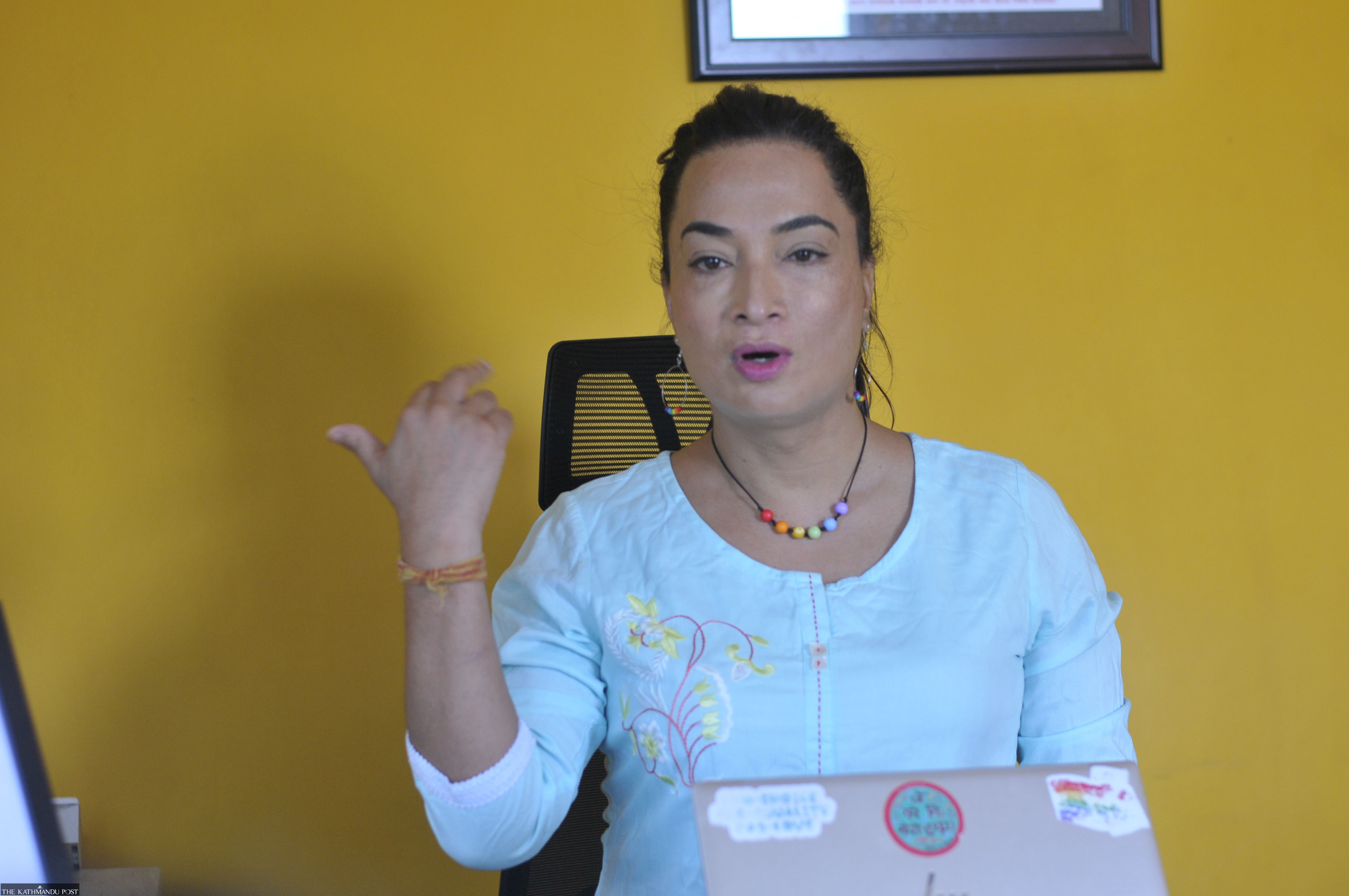
When it comes to cultural acceptance, biases still persist. For example, it feels like we’re allowed to express ourselves openly only during the Pride Month in June. When we try to participate in other celebrations like Teej or Gaijatra, society often reacts negatively, asking why we need to “spoil” their festivals. This shows that social change is still lagging, despite the progress in legal rights.
You mentioned that the queer community is often given the surface level of legal recognition. How is the state of the exercise of fundamental rights for LGBTQIA+ people in Nepal?
Labelled as ‘gender and sexual minorities’, our broader struggles are ignored. When we raise concerns about poverty, food insecurity, or unemployment, the response we often get from government institutions and stakeholders is, “This isn’t our issue; it’s a gender problem.”
We are just as much a part of society as anyone else. Issues like climate change, housing, and poverty affect us too. We want to be included in solutions, whether it’s participating in climate programs or being involved in community initiatives. Unfortunately, lawmakers and stakeholders often overlook that we are just as human as heterosexuals, with needs that go beyond legal recognition on paper.
What are some aspects of the queer community that have not received enough attention in media narratives, and what tends to be unnecessarily highlighted?
As I’ve mentioned before, the narrative surrounding our community often focuses heavily on issues like citizenship, while overlooking other important aspects of our lives. What’s missing is the correct representation of our contributions in various fields. Many LGBTQIA+ individuals are doctors, and experts in different professions, yet their accomplishments are only rarely acknowledged or represented. Instead, the focus often falls on the unfortunate image of some members of the community begging on the streets, which goes viral on social media.
Another issue is the way we are predominantly associated with sex and sexuality. While these are important aspects of human identity, we are much more than that. We have other needs and rights that deserve attention. Unfortunately, the media tends to fixate on sexual aspects of the LGBTQIA+ community, reinforcing stereotypes. It’s time for the media to move beyond this narrow portrayal and include us in broader discussions that reflect the full scope of our lives.
How has the current narrative of progressiveness in Nepal impacted real change for the LGBTQIA+ community?
It’s time to move beyond this narrative of progressiveness. True progress should lead to further development, not be a barrier to it. Unfortunately, the current narrative seems to be stagnating.
For instance, when we raise issues with the government, the response often is, “We’ve already given you the right to citizenship. You’re getting citizenship now.” Even when I travel people sometimes ask, “You’ve got citizenship, right? Things are becoming progressive.” This narrative of progressiveness has become an excuse for the government to claim they’ve done enough and to avoid further action.
This surface-level progressiveness is used to showcase Nepal as forward-thinking internationally, but it hasn’t translated into real change for people at the grassroots. It also impedes activists’ efforts by providing the government with a shield against criticism. Until this narrative of progressiveness evolves into genuine, accountable action that goes beyond court decisions and performative gestures, it will continue to be a barrier to actual progress.




 18.12°C Kathmandu
18.12°C Kathmandu
